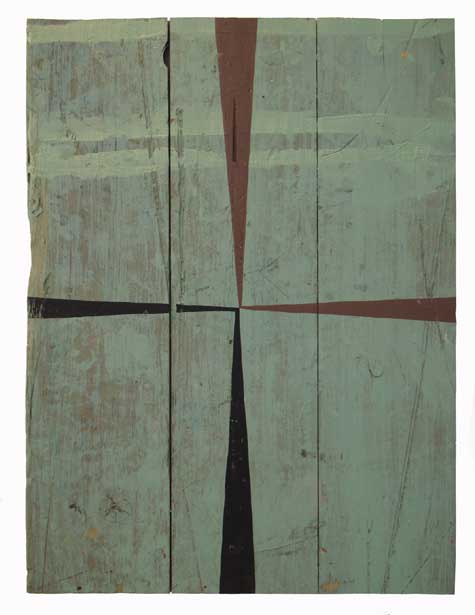 SIMPLY COMPLEX “Whistler,” acrylic on wood panel, 20x15 inches, by Mark Wethli, 2009. |
Throughout his long career Mark Wethli's work has been studied, careful, and formally rigorous. The figurative paintings that occupied a large part of his career often had the illusion of a space divided into sections by a formal architecture that was both a frame for the paintings' subjects and part of their content.
In later years his large wall paintings have had a formal relationship based on color. The structure was created by the borders between rectangular color areas and the relationships induced by the colors' apparent distance form the viewer.
The common thread through all his work has been comprehensibility. In his full-scale model of a Piper Cub airplane, he built an appreciation to a basic machine that can be fully understood in detail. A Cub's frameworks are simple, its controls are mechanical, and it is flown by hand. It's a mechanism based on an ethos of human scale, long since superseded by the complexities of modern aircraft systems.
In his new work now on view at Icon in Brunswick his ethos of simplicity and rigor add up to paintings that are fundamentally radical. Wethli has made conceptual choices that have resulted in visual relationships that are at once familiar and highly original.
The show is 25 small paintings on wood that has been distressed by use. They look like they were parts of doors or walls in old barns, where they were scratched, dented, drilled for hinges, and cracked by age or rough treatment. Wethli cut these pieces to the sizes he wanted for his paintings and added color and a simple shape. The result is works that are simple to apprehend and complex to think about.
"Whistler," for example, is made from three vertical boards 20 inches long, held together by cleats attached to the back. The boards are clearly part of a set that was held together for a long time in some other kind of service. One edge of the painting has been shaped by abrasion. There's a small semi-circle in one joint caused by a knot falling out.
The boards have been randomly nicked and scratched in ways that would have been part of the background in the barn, but are now defining qualities of Wethli's presentation. He has painted them with a thin green wash that allows the color of the wood, and the distressing it's been subjected to, to show through. Or maybe he found it already covered with faded paint -- it makes no difference.
What does matter is what he did next. He painted four narrow triangles that come in from each side and more or less meet in the middle. In this painting the bottom and left ones are nearly black, the other two are reddish brown. The triangles, with their slightly offset meeting, divide the painting in four roughly equal quadrants, now separated from each other but still visually united by the seams between the boards and the marks left by their age and use.
This action of painting the triangles is, as is much of what Wethli does, multi-layered. The addition of formal markers onto the distressed wood is a deeply existential act, on par with the hand outlines in the Lascaux caves. It identifies the assemblage as an unquestionable work of art and transforms the scars and knotholes from their original, apparent randomness into marks that are worth our attention. Which they always were, but Wethli gives them context that helps us comprehend what was already there.
These are works that could have only been done by someone who has been thinking about how to make a work of art for many years, the kind of radical thinking that can only come from experience. They are also some of the best works of his I have seen, and I have seen quite a few.
Ken Greenleaf can be reached at ken.greenleaf@gmail.com.
"NEW WORK" | paintings by Mark Wethli | through October 3 | at Icon Contemporary Art, 19 Mason St, Brunswick | 207.725.8157